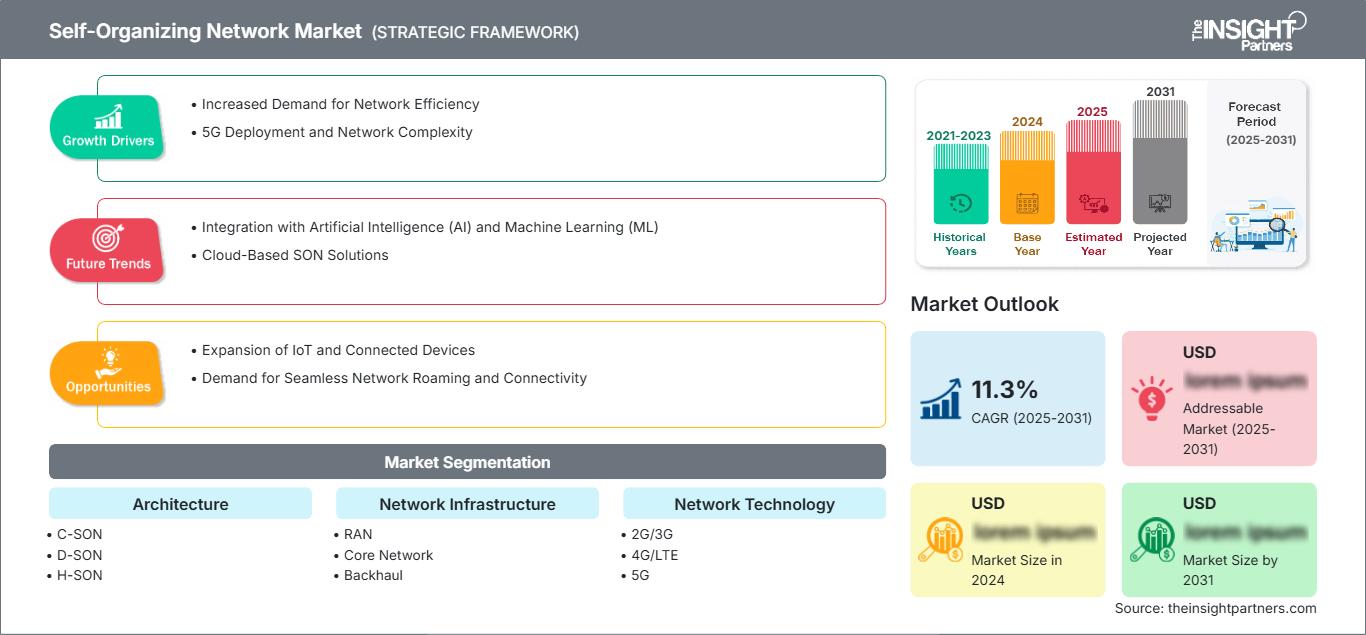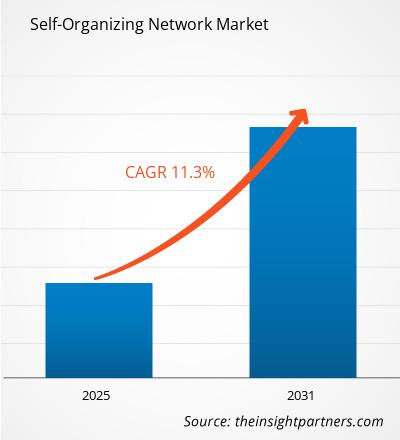自己組織化ネットワーク市場は、2025年から2031年にかけて年平均成長率(CAGR)11.3%で成長し、市場規模は2024年のXX百万米ドルから2031年にはXX百万米ドルに拡大すると予想されています。
本レポートは、アーキテクチャ(C-SON、D-SON、H-SON)、ネットワークインフラストラクチャ(RAN、コアネットワーク、バックホール、Wi-Fi)、ネットワークテクノロジー(2G/3G、4G/LTE、5G)に分類されています。グローバル分析は、地域レベルと主要国別にさらに細分化されています。本レポートでは、上記の分析とセグメントについて米ドル建てでの価値を提供しています。
レポートの目的
The Insight Partnersによる自己組織化ネットワーク市場レポートは、現在の状況と将来の成長、主な推進要因、課題、機会を説明することを目的としています。これにより、次のようなさまざまなビジネス関係者に洞察が提供されます。
- テクノロジープロバイダー/メーカー: 進化する市場のダイナミクスを理解し、潜在的な成長機会を把握して、情報に基づいた戦略的決定を下せるようにします。
- 投資家: 市場の成長率、市場の財務予測、バリューチェーン全体に存在する機会に関する包括的なトレンド分析を実施します。
- 規制機関: 乱用を最小限に抑え、投資家の信頼と信用を維持し、市場の完全性と安定性を維持することを目的として、市場におけるポリシーと警察活動を規制します。
自己組織化ネットワーク市場セグメンテーションアーキテクチャ
- C-SON
- D-SON
- H-SON
ネットワークインフラストラクチャ
- RAN
- コアネットワーク
- バックホール
- Wi-Fi
ネットワークテクノロジー
- 2G/3G
- 4G/LTE
- 5G
地理
- 北米
- ヨーロッパ
- アジア太平洋地域
- 中南米
- 中東およびアフリカ
レポートの一部、国レベルの分析、Excelデータパックなどを含め、スタートアップ&大学向けに特別オファーや割引もご利用いただけます(無償)
自己組織化ネットワーク市場: 戦略的洞察

- このレポートの主要な市場動向を入手してください。この無料サンプルには、市場動向から見積もりや予測に至るまでのデータ分析が含まれます。
自己組織化ネットワーク市場の成長促進要因
- ネットワーク効率に対する需要の増加:特にモバイルおよびブロードバンド ネットワークにおけるネットワーク効率の向上に対する需要の高まりは、自己組織化ネットワーク (SON) 市場の主要な推進力となっています。SON はネットワーク管理を自動化し、より迅速な導入、最適化、およびトラブルシューティングを可能にします。この効率性により、人的介入が削減され、ネットワーク パフォーマンスが向上し、運用コストが最小限に抑えられるため、ネットワーク トラフィックが継続的に増加する中で、通信事業者にとって非常に魅力的なものとなっています。
- 5G の導入とネットワークの複雑さ:5G ネットワークの展開により、SON 市場が大幅に拡大しています。5G ネットワークでは、複雑さの増大と高速で低遅延の接続に対する需要により、非常に効率的でスケーラブルな適応型の管理システムが求められています。 SONテクノロジーは、通信事業者が膨大な数の接続デバイスを管理し、多様な5Gネットワーク全体で最適なパフォーマンスを確保するのに役立ちます。
自己組織化ネットワーク市場の将来の動向
- 人工知能(AI)と機械学習(ML)との統合:AIとMLをSONテクノロジーに統合する傾向が高まっています。これらのテクノロジーにより、予測分析、自動意思決定、継続的なネットワーク最適化が可能になります。AIとMLを活用することで、SONはネットワークの問題をより適切に予測し、トラフィック管理を改善し、ユーザーエクスペリエンスを向上させることができ、通信事業者はネットワークの健全性を積極的に管理できます。
- クラウドベースのSONソリューション:クラウドベースのSONソリューションは、その拡張性、費用対効果、柔軟性からますます人気が高まっています。クラウドインフラストラクチャは、特にマルチベンダー環境において、シームレスなネットワーク管理と最適化を可能にします。 SON機能をクラウドに移行することで、通信事業者は設備投資を削減し、ネットワークの俊敏性を高め、サービス提供全体を向上させることができます。
自己組織化ネットワークの市場機会
- IoTと接続デバイスの拡大:モノのインターネット(IoT)の急速な成長と接続デバイス数の増加は、SONテクノロジーに大きなビジネスチャンスをもたらします。IoTエコシステムの拡大に伴い、膨大な数のデバイスに対応するための効率的なネットワーク管理の必要性が高まっています。SONは、トラフィックパターンに動的に適応することでネットワークパフォーマンスを最適化し、接続性とパフォーマンスを確保します。
- シームレスなネットワークローミングと接続性への需要:モバイルユーザーは地域やネットワークをまたいだシームレスな接続を求めており、SONテクノロジーはネットワークローミングとハンドオーバーを改善する機会を提供します。SONはネットワーク最適化を自動化することで、ユーザーが地理的に異なる地域を移動したり、ネットワーク事業者を切り替えたりする際に、中断のないサービス体験を提供します。
自己組織化ネットワーク市場の地域別分析
予測期間を通じて自己組織化ネットワーク市場に影響を与える地域的な傾向と要因は、The Insight Partnersのアナリストによって詳細に説明されています。このセクションでは、北米、ヨーロッパ、アジア太平洋、中東・アフリカ、中南米における自己組織化ネットワーク市場のセグメントと地域についても説明します。
自己組織化ネットワーク市場レポートの範囲
| レポート属性 | 詳細 |
|---|---|
| の市場規模 2024 | US$ XX million |
| 市場規模別 2031 | US$ XX Million |
| 世界的なCAGR (2025 - 2031) | 11.3% |
| 過去データ | 2021-2023 |
| 予測期間 | 2025-2031 |
| 対象セグメント |
By アーキテクチャ
|
| 対象地域と国 | 北米
|
| 市場リーダーと主要企業の概要 |
|
自己組織化ネットワーク市場におけるプレーヤー密度:ビジネスダイナミクスへの影響を理解する
自己組織化ネットワーク市場は、消費者の嗜好の変化、技術の進歩、製品メリットへの認知度の向上といった要因によるエンドユーザーの需要増加に牽引され、急速に成長しています。需要の増加に伴い、企業は製品ラインナップの拡充、消費者ニーズへの対応、そして新たなトレンドの活用を進めており、これが市場の成長をさらに加速させています。

- 入手 自己組織化ネットワーク市場 主要プレーヤーの概要
主なセールスポイント
- 包括的な調査範囲:本レポートは、自己組織化ネットワーク市場における製品、サービス、タイプ、エンドユーザーの分析を包括的に網羅し、包括的な展望を提供しています。
- 専門家による分析:本レポートは、業界の専門家とアナリストの深い理解に基づいて作成されています。
- 最新情報:本レポートは、最新の情報とデータトレンドを網羅しているため、ビジネスの関連性を保証します。
- カスタマイズオプション:本レポートは、特定のクライアントの要件に対応し、ビジネス戦略に適切に適合するようにカスタマイズできます。
したがって、自己組織化ネットワーク市場に関する調査レポートは、業界のシナリオと成長の見通しを解読し理解するための先導役となります。いくつかの妥当な懸念事項があるかもしれませんが、本レポートの全体的なメリットは、デメリットを上回る傾向があります。
- 過去2年間の分析、基準年、CAGRによる予測(7年間)
- PEST分析とSWOT分析
- 市場規模価値/数量 - 世界、地域、国
- 業界と競争環境
- Excel データセット
最新レポート
お客様の声
購入理由
- 情報に基づいた意思決定
- 市場動向の理解
- 競合分析
- 顧客インサイト
- 市場予測
- リスク軽減
- 戦略計画
- 投資の正当性
- 新興市場の特定
- マーケティング戦略の強化
- 業務効率の向上
- 規制動向への対応




















 無料サンプルを入手 - 自己組織化ネットワーク市場
無料サンプルを入手 - 自己組織化ネットワーク市場